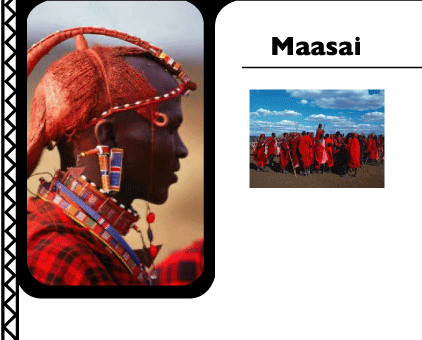|
|
Arrow so he
could derive his livelihood from hunting--he became a
hunter. The second son received a Hoe and became a gardener/farmer
and the third son (who was his father's favorite) was
given a Rod with which he would herd his father's cattle
once he inherited them.
Naiteru-Kop's last son is thus
believed to be the immediate descendent of the Maasai
people, the great warrior people who roam the endless
plains of southern Kenya and northern Tanzania in Eastern
Africa. This story is taught and passed on by Maasai from
generation to generation. The story also explains the
Maasai's reverence for nature and their spiritual attachment
to livestock as a source of food and wealth.
Impact of Colonialism
Some Maasai believe that this myth reveals their real
origin, while others believe that the Maasai are one
of the lost tribes of Israel who, many centuries ago,
followed the great Rift Valley and settled in present-day
Kenya and Tanzania. Anthropological studies strongly
suggest that the Maasai have inhabited East Africa for
more than 6,500 years.
Up to the 18th century, Maasai
territory stretched from the northern part of Kenya
to central Tanzania, 700 miles from north to south and
500 miles east to west. The arrival of the British colonizers
and the subsequent displacement of the Maasai people
from their traditional lands followed the discovery
of Maasailand by Joseph Thompson of the National Geographic
Society in 1883. This resulted in a full scale war between
the British and the Maasai people. Through a combination
of political maneuvering, introduction of peculiar human
and livestock diseases, and superior firepower, the
Maasai population was reduced from 500,000 to a mere
40,000 by the early 1900s.
Too weak and few to defend
their land, the Maasai conceded defeat. It was then
that the British began the long process of dispossessing
the Maasai of their lands. This led to the creation
of two Maasai reservations in the northern part of Kenya
and along and across the border with Tanzania. By 1904,
the Maasai had lost two-thirds of their prime seasonal
grazing lands that were later dubbed "Kenya White
Highlands."
The Legacy of "Conservation"
The legacy of British rule in East Africa has continued
to haunt many Maasai generations. The British were attracted
to Maasailand because of its excellent and varied climate,
the beauty of the landscape, and the extraordinarily
rich wildlife--both flora and fauna. Commercial trophy
hunting of large game was an added attraction which
popularized East Africa and Maasailand. By 1930, hunting
already threatened many wildlife species with extinction,
leading to a conference in London in 1933 to determine
the status and future of East Africa's wildlife. Following
the resolutions of this conference, national parks and
game preserves were created across Maasailand in an
attempt to ensure the survival of wildlife in the region.
Today, wildlife preserves in
Kenya and Tanzania form 14 percent and 16 percent of
the total land surface respectively. Wildlife preserves
in Maasailand and remaining communal Maasai lands are
sanctuaries for 80 percent of the region's wildlife.
Some of the well-known wildlife preserves in Kenya's
Maasailand include: Maasai Mara National Reserve, Amboseli
National Park, Samburu Game Reserve, Losai National
Park, Shaba National Reserve, Buffalo Springs, Maralal
Sanctuary and Tsavo West in Kenya. In Tanzania they
include Serengeti National Park, Lake Manyara National
Park, Maswa Game Reserve, Ngorongoro Conservation Area,
Mkomazi Game Reserve and Loliondo Concession Area (currently
an exclusive hunting area for wealthy Arabs and Westerners).
Coexistence with Wildlife
The Maasai have lived in harmony within rich ecosystems
of East Africa for years. The concentration of wildlife
conservation areas in Maasai territories, and the sheer
abundance of wildlife in the communal Maasai lands,
have been attributed to Maasai reverence for and custodial
attitude toward nature. Maasai culture promotes wise
use of non-renewable natural resources; present generations
are only holding them in trust for future generations.
Maasai tradition prohibits killing of wildlife for commercial
use, or destruction of forests or any part of natural
ecosystems. Wildlife still thrives in Maasailand, unlike
in many other parts of the region where wild animals
have been eliminated either for food or to give way
to commercial agriculture.
Commercial agriculture, insensitive
tourism practices and continued loss of traditional
Maasai lands to modern economic development all threaten
the survival of the Maasai people, wildlife and their
shared habitat. Destruction of forests, commercial hunting
and loss to development of traditional wildlife migratory
routes and breeding grounds are responsible for the
rapid extinction of biodiversity in Maasailand. Tourism
has become environmentally insensitive. Tourism earns
the two governments of our two countries millions of
dollars each year, but the Maasai now view it as an
unethical practice and a means of exploitation that
violates their culture and undermines their relationship
with nature. This reality calls for a new approach to
tourism that benefits the local people, is in harmony
with the environment and respects the culture of the
Maasai people.
Shape of the Future
Presently, the Maasai people of Kenya and Tanzania,
and their rich and unique culture, are threatened with
extinction. There is need to consider the implications
of such a tragedy, not only for East Africa but for
all civilization. This crisis goes far beyond present
political and economic interests. Recent research confirms
the historical trends leading to the current situation
and pinpoints the existing economic and political forces
that are intensifying the threat. The policies of Kenya
and Tanzania must be altered and radical changes made
in tourism and development practices if the loss of
the Maasai people, wildlife--their shared habitat--are
to be avoided.
There is an urgent need to
restore the Maasai peoples' traditions. Equally important
is true political representation of the Maasai in the
central governments. The Maasai lack representation
in almost all sectors of national government. Often
their representatives are either people from elsewhere,
or those appointed to serve the economic and political
interests of powerful people in government. Finally,
in order to ensure that the Maasai benefit from tourism
and the environment, the industry ought to shift its
operations from regular tourism to ecotourism. Ecotourism
will benefit the Maasai people economically while safeguarding
the environment and the culture of the Maasai people.
|
|













